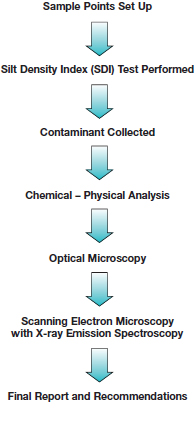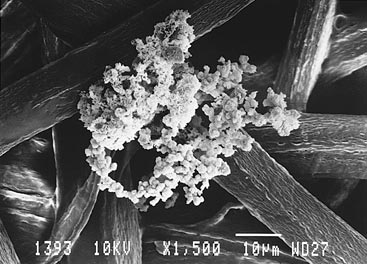The presence of unexpected particulate or microbial contaminants in process fluids can lead to system failure, batch reprocessing, or even batch rejection. It is critical that these contaminants be quickly isolated and identified, so that possible sources can be traced and corrective actions applied to the process.
requires specialist laboratory facilities and expertise, all of which can be offered by Pall Life Sciences. Typical microbiological studies include:
How Can Pall Help?
Pall has over fifty years experience in contamination analysis and control and offers a range of standard services for analysis of particulate and microbial contaminants. In the simplest form, we can often provide the necessary advice and corrective actions by telephone or via e-mail. Alternatively, samples can be sent to a Pall facility for analysis or we can sample on site. These investigations will be fully documented and a technical report is supplied following conclusion of the test work and process review, to ensure that any change control is correctly managed and implemented.Microbiological Contaminants
The isolation and identification of microbiological contaminants from process fluidsrequires specialist laboratory facilities and expertise, all of which can be offered by Pall Life Sciences. Typical microbiological studies include:
- Total bacterial count
- Bioburden analysis
- Identification and review of process isolates
Particulate Contaminants
Pall Life Sciences have available a wide range of microscopic and analytical equipment for the analysis of particulate and/or amorphous contaminants including:- Optical microscopy
- Scanning electron microscopy
- X-Ray emission spectroscopy
- Computer-enhanced image analysis
Analysis of Process Bioburden
The full quantification and identification of natural process bioburden is of increasing regulatory interest. Some bacteria, when subjected to particular environmental conditions, are known to produce particularly diminutive forms capable of penetrating 0.2 µm sterilizing grade filter cartridges. A typical analysis procedure is as follows:- Filter samples through 47 mm diameter analysis discs
- Place discs on nutrient agar plates and incubate
- Count colonies to quantify bioburden Strike out individual colony types
- Examine colony morphology
- Gram stain and examine microscopically
- Perform biochemical tests to establish identity
- Document and report results
Typical Investigation Procedure for Particulate Contaminants in
a Water System

SEM Showing Contamination Retained by Filter Membrane

Services, Services, Bottled Water, Bottled Water, Wine, Cider, Housings, Services, Test Kits & Devices, Integrity Testing, Dairy, Food and Ingredients, Food and Ingredients, Soft Drinks, Bottled Water, Wine, Juice, Cider, Pet Food, Beer (Craft/Micro Breweries), Beer (Corporate), Food Safety, Quality Control, Quality Control, Quality Control, Bottled Water, Dairy, Dairy, Bottled Water, Bottled Water, Bottled Water, Bottled Water, Dairy, Dairy, Dairy, Bottled Water, Dairy, Dairy, Dairy, Spirits, Spirits, Spirits, Spirits, Spirits, Spirits, Spirits, Bottled Water, Spirits, Spirits, Spirits, Spirits, Food and Ingredients, Food and Ingredients, Food and Ingredients, Food and Ingredients, Food and Ingredients, Food and Ingredients, Bottled Water, Soft Drinks, Soft Drinks, Soft Drinks, Soft Drinks, Soft Drinks, Soft Drinks, Soft Drinks, Soft Drinks, Soft Drinks, Soft Drinks, Bottled Water, Soft Drinks, Soft Drinks, Soft Drinks, Soft Drinks, Soft Drinks, Soft Drinks, Wine, Wine, Wine, Wine, Bottled Water, Wine, Wine, Wine, Wine, Wine, Wine, Wine, Juice, Juice, Juice, Bottled Water, Juice, Juice, Juice, Juice, Juice, Cider, Cider, Cider, Cider, Cider, Bottled Water, Cider, Beer (Craft/Micro Breweries), Beer (Craft/Micro Breweries), Beer (Craft/Micro Breweries), Beer (Craft/Micro Breweries), Beer (Craft/Micro Breweries), Beer (Craft/Micro Breweries), Beer (Craft/Micro Breweries), Beer (Corporate), Beer (Corporate), Bottled Water, Beer (Corporate), Beer (Corporate), Beer (Corporate), Beer (Corporate), Beer (Corporate), Beer (Corporate), Beer (Corporate), Beer (Corporate), Cider, Cider
Services
Testing, Diagnostics
Charges
Wherever possible, we provide a fixed price in advance for the project. Where this is not possible, we will give an estimate to assist you in budgeting and cost control. The final invoice gives details on items such as labor, and materials.Part Number Structure
Pall's part number structure is for reference during the ordering process. A Pall representative will assign the specific service part number applicable to your service requirements.
Typical Part Number: PTS04AE (Contamination analysis with scanning electron microscopy and XES).
What’s the Next Step?
Please contact Pall. A representative will discuss your specific requirements with you and forward your enquiry to Pall contamination analysis specialists.
Earn 10% off* your next order online by leaving a review of this product. Please login to your account to leave a review. We appreciate and value your feedback.
*Subject to Terms and Conditions.



